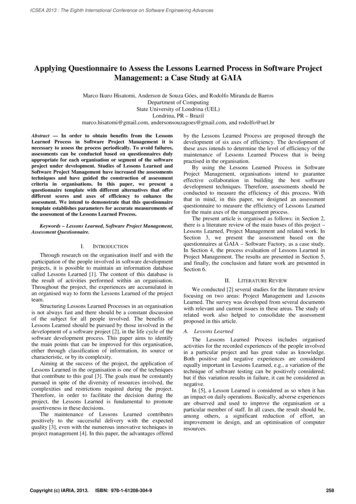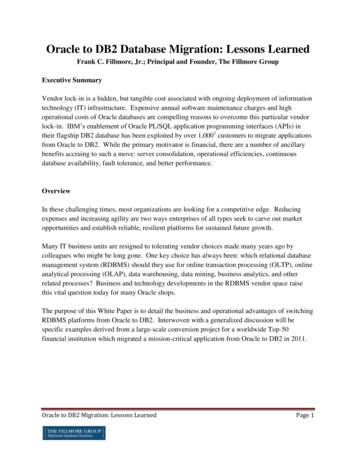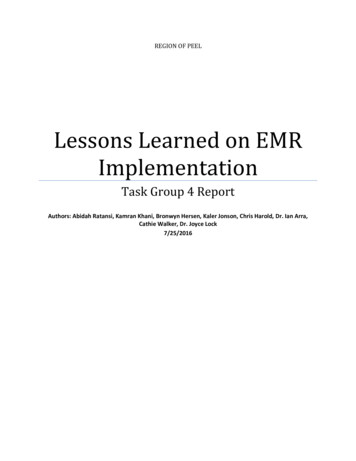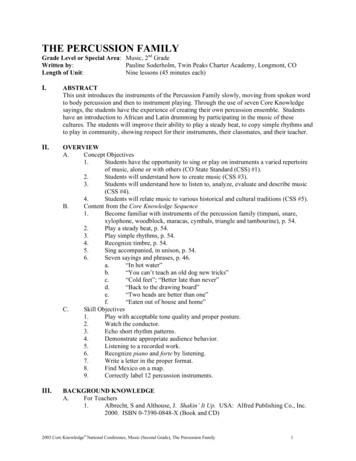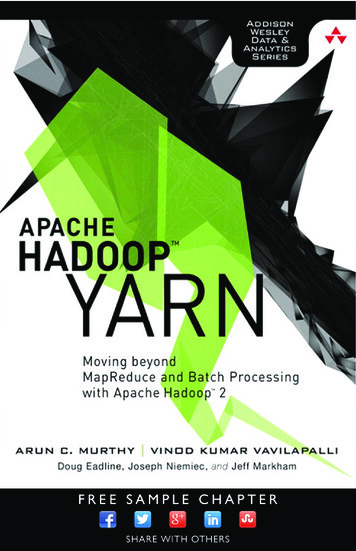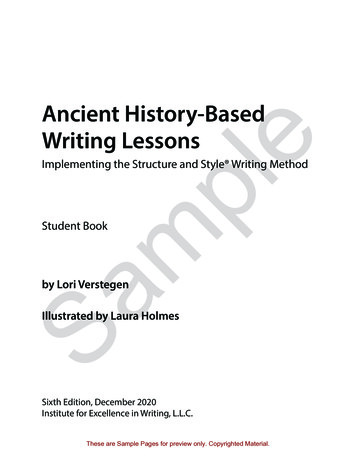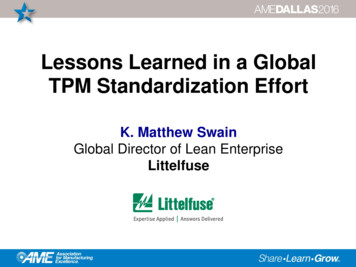
Transcription
Lessons Learned in a GlobalTPM Standardization EffortK. Matthew SwainGlobal Director of Lean EnterpriseLittelfuse
Lessons Learned in a Global TPMStandardization Effort In 2011 a team of lean leaders and maintenance managersdetermined that standard work for Littelfuse TPM was criticalto the company’s success. Since then, Littelfuse has madetremendous progress. They’ve launched (and in some casescompleted) ambitious efforts to overhaul 100% of theequipment to “like new” or “better than new” status infacilities that have 600 complex machines and develop a“TPM Plan for Every Plant” that extends through 2015. Thispresentation will outline the eight aspects of Littelfuse LeanEnterprise TPM; lessons captured about the pain points instandardization efforts—and how to avoid them; and criticalaspects of starting and continuing a TPM rollout, includinghow to get executive buy-in, how to prioritize, and the keypoints and successes of the “overhauling” kaizen blitz.
What We Will Discuss Today Littelfuse, Inc.Littelfuse TPM definition and benefitsThe goalManagement support and buy-inTrainingThe Littelfuse TPM (Overhaul) Kaizen Blitz & OEELittelfuse TPM System (our 8 elements)Re-launch: The 2014 plan, continuing in 2015ResultsLessons learned and best practicesExamples
The #1 Brand in Circuit Protection — EmergingPlayer in Power Control and SensingElectronics (49%) Passives Semis SensorsAutomotive (35%) Auto Fuse Commercial Vehicle SensorsElectrical (16%) Power Fuse Relay/CustomLittelfuse has the broadest and deepest portfolio of circuit protection products serving three majormarket segments.
Our Customers Are Global MarketLeadersLEADING OEMsGlobal Distribution PartnersEMS/ODMTIER 1 AUTO
Purpose-Driven ExcellenceOrganic Growth (5%) Growth that comes from a company'sexisting businesses, growth of the coreof the companyAcquisition Growth (10%)AcquisitionOrganic Growth by acquiring businesses,measured by the amount ofpurchased revenue Performance after acquisitionbusiness is our responsibility andtreated as Organic GrowthProtect and Grow the CoreOrganizational Development /Littelfuse LeanEnterpriseFoundational Structure for Littelfuse Strategy 2013 to 2017
Littelfuse Lean EnterpriseLeanManufacturing& OperationsLeanNew ma
Main Principle of Littelfuse TPM The last time a tool or machine is used, it shouldperform more effectively and with higher qualitythan the day it was released to production
Definition of Littelfuse TPM TPM is a process that maximizes the productivity ofequipment for its entire life cycle Through the participation of all employees, TPMcreates an environment that encouragesimprovement efforts in safety, quality, cost, delivery,and creativity TPM is a major tool in the pursuit of perfection: zerodefects (and zero unplanned equipment stops)
TPM - Benefits of Increased EquipmentReliability These items decrease:––––––Scrap ( )Mean Time to Repair (MTTR)Average cost to repair ( )Number of emergencies, impactMaintenance overtime ( )Emergency purchases, air freight( )– Repair parts cost ( )– Spare parts inventory ( )– Equipment life cycle costs ( ) These items increase:– Quality– Equipment Availability– Mean Time BetweenFailures (MTBF)– Spare parts inventory turns– Equipment repeatability
Proposed Future State with TPM**Present 3.5 years ago for some sites, now for othersTechnicians availableto assist engineeringwith processdevelopment
Big Picture Future State (Goal)AssemblyAssociateTechnicianManufacturing Engineer Product DevelopmentEngineerMore NewProducts
Littelfuse Management Support/Buy-InWhat we did:– Obtained management supportby manufacturing site or triedto anyway– Launched TPM by site withseparate goals and objectives– Stumbled in North America,the Philippines, and SouthernChina and succeeded inNorthern China– Re-launched with executivesponsorshipWhat we should have done:– Obtained executive teamsupport using results data fromoutside of Littelfuse– Launched TPM globally withstandardized goals andobjectives– Used executive team support toimplement faster and drive thesupport and reporting rigorthat only an executive team canprovide– Focus on bottleneck equipment
Training TPM training is part of the Littelfuse lean trainingprogram– Phase 2 of 6– Covers the tools noted in the Littelfuse TPM system
Phases of Core Lean Training Phase 1 : Gemba Guide, Leader Standard Work, TieredMeetings, A3, Hoshin Kanri, True North Metrics,Benchmarking, Assessments Phase 2 : The 8 wastes, LSGA, 6S, Standard Work, TPM,OEE, SMED, VOC. Phase 3 : TQM, Quality at the Source, Jidoka, Value StreamMapping, SIPOC, Kaizen Phase 4 : 3P, Supply Chain, Flow, Training Within Industry Phase 5 : Muri, Pull, Kanban, Level Loading, ProjectManagement, VA-VE Phase 6 : Lean Product Development Six Sigma : Black Belt, Green Belt, Yellow Belt
Littelfuse TPM (Overhaul) Kaizen Blitz Before:– Data gathering (OEE, uptime, Pareto of downtime causes,operator input, etc.)– Gather needed materials for the target machine (newPlexiglas , pneumatic tubing and fittings, cleaningmaterials, tools, etc.)OEE Availability Performance QualityWhen or how often do you lose totalavailability of your equipment?Does your equipment start and stop alot?Do you manufacture qualityproducts?How long are your set-ups?Does your equipment run at 100% of itsdesigned speed?Are your processes repeatable?Does your equipment break downfrequently?
Littelfuse TPM (Overhaul) Kaizen Blitz During:– Complete or review the machine/equipment or processFMEA– Complete/review/upgrade the preventive maintenanceprocedure (focus on high RPN items from the FMEA)– Compose the autonomous maintenance procedure (limit to10 minutes per shift) Best Practice: Recommend autonomous maintenance at end ofshift with next shift providing verification prior to start– Overhaul the machine to like new condition (or better)– Develop “proper” spare parts listFMEA Failure Mode and Effects AnalysisRPN Risk Priority Number
Littelfuse TPM (Overhaul) Kaizen Blitz After:– Complete an A3 and enter it into Project Tracker– Monitor: uptime, performance, quality, availability, OEE Consider constructing SPC charts for each of these attributes forcritical machines– Update management periodicallySPC Statistical Process Control
The Most Important Lesson Learned:Communication“The single biggest problem in communication is the illusionthat it has actually taken place.”– George Bernard Shaw
The Most Important Lesson Learned:Communication Construct a communication plan and follow it!
The Most Important Lesson Learned:Communication Consider:– Weekly updates to departments involved– Monthly updates to management teams– Quarterly updates to the executive team If needed, meet with each executive in person and review statusupdates
Monthly Update/Sharing MeetingsMatamoros, Mexico
Monthly Corporate TPM Updates52% of the 4,076 total LF machines have been through first roundof their TPM overhaul!
Inventing the Littelfuse TPM System Mission:– Obtain TPM program buy in from all sites– Kaizen: Gather volunteers from all sites to “invent” yourprogram “Invented here” ownership– R&D (rob and duplicate) and benchmark productivityinc.com, ame.org, local/state manufacturingpartnership, etc. Use best practices from within
Inventing the Littelfuse TPM System Mission Accomplished:– The Littelfuse effort required 2 kaizen blitz events and endedwith a 50-page document detailing the Littelfuse TPMSystem All sites now use the same vocabulary and equations (prior tostandardization we had many ways to measure OEE) We now have TPM standard work to share with acquired companies
TPM Updates September 2011 TPM Started 2012 Littelfuse TPM Manual Completed Today on Revision 16
The Littelfuse TPM SystemSpare PartsMgmt.Standardized Equipment Spec.Equipment FMEA.3P for Manufacturing.Cradle to Grave Equipment Mgmt.PMs Per MonthRepairs Per Month.CI ility (Up-time)SelfDirectedWork TeamsTotal ProductiveMaintenanceSAPOracleBigfootCustom SoftwareRestoration.6S for Machine.7 Step Implementation.Check SheetsSAP Managed SparesVMI Spares/Local Tool CribABC Equipment MgmtPreventiveandPredictiveMaint.SMEDSet-up ReductionKaizenStandard WorkLSGA TeamsA3, KaizenTrue North MetricsTime or “Miles” Based PM SystemOEM Recommended PMEquipment Component StandardizationMachine Specific Maintenance TrainingMTTR & MTBFFirst Pass YieldSPC
Inventing the Littelfuse TPM System Lesson Learned: Include all forms in the scope– Littelfuse initially considered consolidation of the SMED,Standard Work, Autonomous Maintenance, PreventiveMaintenance, FMEA forms out of scope Secondary effort was needed to standardize all forms
The New Plan with Executive TeamSupport Launch TPM at ALL locations (some done) Inventory all equipment and prioritize high-impactareas first– Work off of a pull system– Complete a TPM blitz on the target machine and then usethe learning to overhaul all similar tools (FMEA, AM, and PMcompleted on the first machine) Staff appropriately and choose your most capable (re:TPM) local person to be in charge of the effort Monthly meetings and status updates
The 2015 Plan
One Facility’s Results October 2011– First TPM Kaizen Completed End of 2012– Total Number of Machines Targeted for 2012 TPM 204– Number of Machines Overhauled by November 2012 204
TNMs – Cost/ProductivityCartridge Fuse TechniciansTPM StartedSuzhou Weekly Sales/Associate 2,300 2,100 1,900 1,700 1,500 1,300 1,100 900 700 5002011201220132014
OEE Example 00%Mach. 1Mach. 2Mach. 3Mach. 4Mach. 5Ave.
Availability: Machine Status Example Graph100%90%80%70%Non-Scheduled Time60%Unscheduled Downtime50%Scheduled DowntimeEngineering Time40%Standby Time30%Productive Time20%10%0%Mach. 1Mach. 2Mach. 3Mach. 4Mach. 5Target for TPM kaizenAve.
Traditional Productivity Losses and SEMIProductivity Loss CategoryEquipment FailureProcess FailureFacilities FailureAutomation FailurePMQualificationSet-upNo OperatorNo ProductNo Automation InputSEMI E10Major heduledDowntimeStandbyTimeEngineeringLimited CapacitySlow SpeedMinor StopsScrap & ReworkNot ScheduledOff Line TrainingInstall/DecommissionPerformanceEngineering TimeProductiveTimeNon-ScheduledTimeQuality
TPM’s Effect on Our Associates “In the past it was a struggle to makeshipments. Now it is easy and operators areless stressed.”-Sr. Director of Operations “the machine” “my machine”-Associates
A Few Littelfuse Best Practices TPM Standard Work: The Littelfuse TPM System– Use of a custom Littelfuse Equipment Management System(EMS) to calculate OEE for all equipment (not deployed atall locations yet)– LSGA Lean Small Group Activity All operators are on a CI team and part of their team charter is toimprove TPM
A Few Littelfuse Best Practices Visual Equipment Management (by dept.)Color code:White Non-Scheduled (off line; no parts or no operator)Bright Green Running ProductionLight Green AvailableYellow (not shown) Machine Down/Under RepairRed Machine Down
Examples The next slides are a few examples of TPM relatedprojects
Spare Parts Inventory ManagementSuzhou Fuse Plant Spare Parts 14Spare Parts Inventory value (US )May'14Jun'14Jul'14Aug'14Spare Parts Inv Days Spare Parts ABC management Spare Parts Inventory Standardized Spare Parts Life Cycle Improvement Timely Spare Parts Inventory Review by Maintenance EngineeringSep'14Oct'14
Spare Parts Cost Improvement OEE improvement helps decrease cost Spare parts life cycle improvement Focused improvement project for the expensive parts
Overhaul EventDuringAfter Machine scrap reduced 50% Annual PM reduced from 16 hours to under 4 hours
TPM HighlightsBefore Cycle time per piece: 4 min and 13 sec. to4 min and 40 sec. Due to wait time for electrode cool down Parts per hour: 14After Cycle time per piece : 34 seconds No need to wait for the electrodes to cooldown Parts per hour: 90
TPM Highlights
TPM HighlightsGuide Post & Bushing Cost-Stamping knife consumption by 30K/yr-Guide post and bushing resourced from Steinel toMisumi, 31K/yr savingsStamping Knife( 48 ea)Consumption of stampingknife from Apr - June2014; one cause: worn-outguide post and bushingDicing Spindle Motor Cost-From purchased to refurbished in-house: 6.5K x 3motors 19.5K savingsCompressed Air-240 min/day idle or 463/machine/yr- 10K/yr savings for 22 m/cAdded shut-off valve when idleBarrier Print Wheel Cost-Print wheel consumption to be reduced by 21K(2015)Before: 496 eaLasts 7 daysRubber printwheel hubdisposedAfter: 0.30 eaLasts 20 days Only rubberdisposed
Pressing Machine OEE ImprovementPareto chart of 10# pressing DT yJunJulAugSepOctActual 65%64%85%88%84%85%85%85%84%85%Target overEquipment Waiting time : SMED Event - reduced the C/O time from 60Action: Assess the pressureminutes to 40.capability of the machine,upgrade the 25S mould countfrom 3 to 5.
Summary TPM is foundational– Creates the basic stability for continuous improvement Management support is critical to success– But remember, it is contingent on communication of results
Questions?
Thank You!Your opinion is important to us!Please take a moment to complete thesurvey using the conference mobile app.Session: (i.e. TP/16 - # to be advised)Lessons Learned in a Global TPMStandardization EffortK. Matthew SwainLittelfusemswain@littelfuse.com
Definition of Littelfuse TPM TPM is a process that maximizes the productivity of equipment for its entire life cycle Through the participation of all employees, TPM creates an environment that encourages improvement efforts in safety, quality, cost, delivery, and creativity TPM is a major tool in the pursuit of perfection: zero



